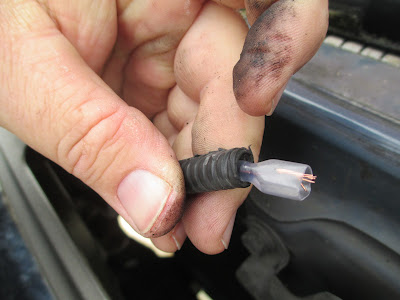We try to make do with what we have around here.
We believe in the adage,
"Use it up, Wear it out,
Make it do, or Do without."
Big K is mighty handy.
He can fix so many things
and I marvel at the way his brain
so easily figures out all things mechanical.
The horn in his truck didn't always work,
creating a dangerous situation
should the need arise to use it.
He decided to replace it.
We believe in the adage,
"Use it up, Wear it out,
Make it do, or Do without."
Big K is mighty handy.
He can fix so many things
and I marvel at the way his brain
so easily figures out all things mechanical.
The horn in his truck didn't always work,
creating a dangerous situation
should the need arise to use it.
He decided to replace it.
On his 2000 Nissan truck,
the horn is located
just in front of the radiator.
Here is the new horn
and the socket wrench used to change it.
A pair of wire strippers is also needed.
The old horn is removed.
The original wire connector is cut off
using the wire strippers
because it won't fit the new horn.
The black plastic cover is cut back
and the wire is stripped about 1/2 inch.
The new connector consists of
the insulator (clear plastic)
and the connector (metal).
It comes in the kit.
The clear plastic insulator is inserted
into the trimmed black plastic cover over the wires.
The freshly stripped wires are fed into the metal connector.
The wire strippers are used to crimp
the connector over the wires.
The wires should fit in the connector snugly.
The connector is then inserted into the horn.
The other connector (on the left) is the ground
and comes already assembled.
It needs to be attached to the mounting bracket of the horn.
The whole process took less than 15 minutes.
Now we'll all be a lot safer out on the road.
It feels good to be able to maintain our older vehicles.
























































